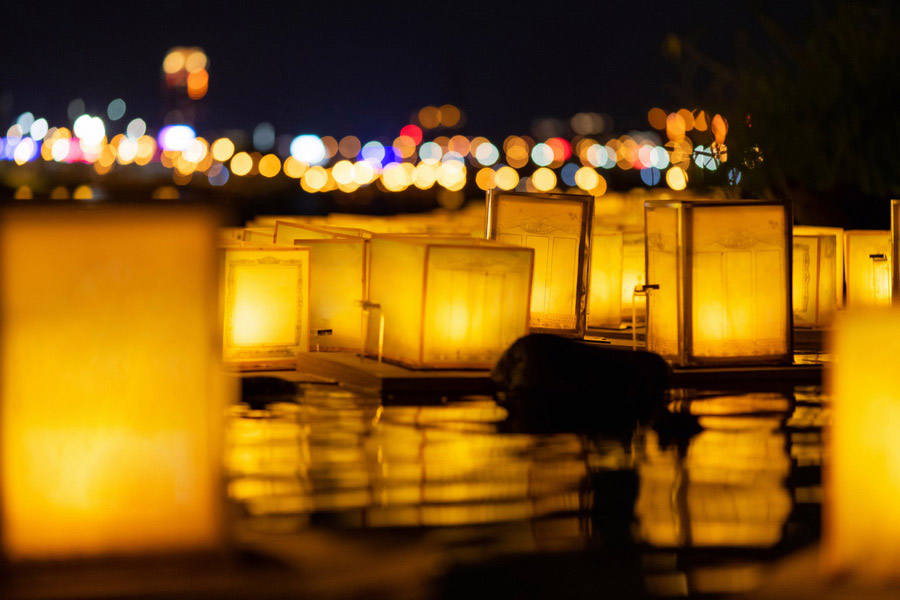Obon Festival

Obon Matsuri (お盆), or simply Bon, is one of the most significant Buddhist holidays in Japan, dedicated to honouring the deceased and paying respect to their souls. During Obon, it is believed that ancestors' spirits return to Earth to spend time with the living, only to leave our world once more at the end of the holiday. This celebration can be likened to a "family reunion", in which living relatives and the spirits of the deceased come together. It is a special time when the thin line between the world of the living and the dead fades, allowing families to reunite.
Typically held in mid-August (though occasionally in early September), Obon features dancing, prayers, offerings, and ritual fires. The festival's most famous highlight is the Bon Odori dance (盆踊り), which is performed in honour of the spirits. The festivities culminate in a lantern-lighting ceremony, symbolising the return of souls to the afterlife.
History of Obon
Obon is a fusion of Buddhist traditions and Shintoism and influenced by the Chinese Zhongyuan festival. The festival takes its name from the Buddhist event known as Ullambana, which means 'hanging upside down' and symbolises 'great suffering'. As Obon evolved in Japan, it acquired unique features by incorporating elements of local Shinto rituals and customs, making it an important cultural event for the entire country.
The holiday is also rooted in a Buddhist legend about a monk called Mokuren (Maudgalyāyana in Sanskrit), who was a disciple of Buddha. Using his supernatural powers, Mokuren discovered that his mother was suffering in the spirit realm due to unmet commitments from her existence. Seeking the Buddha's assistance, Mokuren was urged to perform a special ceremony in the middle of the seventh month of the lunar calendar. This involved making offerings of food, lanterns, and incense to Buddhist monks returning from their summer retreat. Once these conditions were met, his mother's spirit was released; while she was first reincarnated as a dog, she regained her human form once Mokuren diligently recited sutras. According to legend, Mokuren's immense joy led him to dance, and the Bon Odori dance was born.

When is Obon Celebrated?
Obon is usually celebrated in mid-August, but the date may vary depending on the region of Japan. The main dates for Obon are from August 13 to 16, although in some areas, such as parts of Tokyo, Yokohama, and Tōhoku, it is observed from July 13 to 16. In the northern Kantō region, as well as in parts of the Chūgoku region and the islands of Shikoku Kyūshū, and Okinawa, the festival follows the old lunar calendar, resulting in being a moveable feast each year. During any of these periods, Japanese towns and villages transform with brightly lit lanterns, music, and dancing.
Obon Traditions
Obon is characterised by a strict adherence to tradition, with several key elements:
Meeting of the Ancestral Souls
Obon begins with the "meeting of the souls". On this day, special mukaebi lights are lit at the entrances of houses or in the street to serve as beacons for the spirits, guiding them home. Traditionally, linen was used for mukaebi, but nowadays, electric lanterns are adequate. An altar is prepared inside the house, with bamboo placed in the corners and tied together. A plaque with the name of the deceased is placed on the altar, along with offerings of fruits and flowers, as well as two figures—a horse made of cucumber and a buffalo made of aubergine. The fast horse symbolises the quick arrival of the ancestors in the world of the living, while the buffalo represents their slow and peaceful departure.
Bon Odori Dance
One of the most spectacular rituals of Obon is the Bon Odori, a dance performed in the streets, squares, and temples. This dance symbolises the joy of ancestral spirits returning to the world of the living. Dancers wear brightly coloured yukata (summer kimonos) and perform synchronised movements around a yagura (wooden tower). The accompanying music ranges from folk songs to modern pop, always accompanied by the rhythmic beats of taiko drums. Each prefecture in Japan has its own variations of the dance, which reflect the culture and history of the region.
Daimonji (大文字) - Gozan no Okuribi (五山送り火)

As the festivities come to an end, the Japanese perform the Okuribi, or "fire-walking" ritual, to help the souls return to the afterlife. One of the most beautiful rituals is Tōrō Nagashi, where paper lanterns are floating at the surface of the water. These lanterns symbolise the souls travelling to their world, following the light so as not to get lost. At night, the glowing lanterns floating on rivers or lakes create a mesmerising sight.
Kyoto hosts the ritual festival of Daimonji, Gozan no Okuribi, where huge bonfires shaped like hieroglyphs and characters, such as 大 ("big"), are lit on five mountain slopes, visible from tens of kilometres away. The best views of the fires are from the Nakagyō-ku ward and the Kamo River.
Despite the influence of contemporary technology and urbanisation, Obon remains an important aspect of Japan's spiritual heritage. The holiday serves as a reminder of the value of family ties and the continuing connection with ancestors, even after they have passed away.

